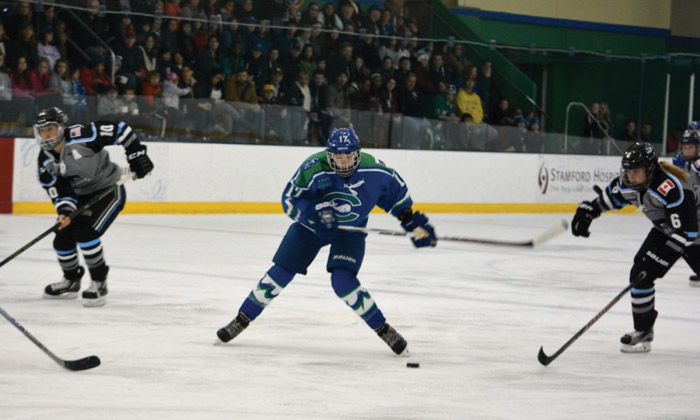Just five months ago, Manon Rheaume—the only woman to ever appear in an NHL game—dropped the ceremonial first puck for the National Women’s Hockey League (NWHL)’s inaugural regular season game between the Boston Beauts and the Buffalo Pride. Rheaume smiled as she found herself, not in between the pipes as she was 30 years ago, but at centre ice, helping usher in a new era for women’s hockey.
The NWHL, conceived in May 2015, holds the distinction of being the only one of North America’s multiple women’s hockey leagues to pay its players. Prior to the league’s establishment, women seeking to play hockey after university had limited opportunities; many ended up in the unpaid Canadian Women’s Hockey League. Recently, however, there has been a surge in interest among female hockey players for a regular competitive atmosphere that would provide compensation similar to that available to their male counterparts.
The NWHL provides just that. The league includes four teams—the Buffalo Beauts, the Boston Pride, the Connecticut Whale, and the New York Riveters—who play against each other every week. Players are compensated a minimum of $10,000 a season and receive 15 percent of their jersey sale profits. Though this salary is meager in comparison with major professional sports leagues, it is largely par for the course with men’s minor leagues.
The NWHL has amassed considerable support over the course of its inaugural season. An entry-level draft took place on June 20, which featured some big names including Hilary Knight and Amanda Kessel (sister of Pittsburgh Penguins right wing Phil Kessel), shortly after which they signed a major broadcast deal with ESPN. In December, the NWHL landed its first high-profile sponsor, Dunkin Donuts, which helped further establish the league’s legitimacy.
Despite the league’s early successes, start-up businesses with goals like the NWHL’s are especially prone to obstacles. Commissioner Dani Rylan has conceded that turnouts for the league’s tryout events, despite the players displaying good talent, was lower than expected. Even the NWHL’s involvement in the NHL’s 2016 Winter Classic in Boston ended in partial devastation when Boston Beauts forward Denna Laing suffered severe spinal damage and partial paralysis after a strong collision with the boards. Despite these setbacks, the league’s success thus far provides reason to be optimistic about not only its future, but about women’s sports in general.
The league’s savvy initiatives to increase its prominence as an exciting and legitimate alternative to mainstream professional sports leagues affords it a respectable position to eye expansion. Gary Bettman and other NHL executives’ willingness to include the NWHL in major events speaks to their enthusiasm to grow the women’s game, and reflects changing public norms towards greater inclusion in sports. As the media moves towards more equal coverage, the NWHL and other women’s leagues will likely gain traction. For now, the NWHL should be proud of its efforts to grow the game and inspire the next Manon Rheaume.
The NWHL All-Star festivities will take place Jan. 23-24 in Buffalo, New York. Standout players Emily Pfalzer and Knight captain two 14-woman rosters that will play two four-on-four periods, with the winning team receiving an equal split of 20 percent of ticket sales profits. The weekend also includes shooting accuracy, fastest skater, trick shot, and agility contests, as well as a VIP skate for fans.
Though still a league in its infancy and lacking a true fanbase, the NWHL has shown true potential. While it may never be as popular as the NHL or other major North American sports leagues, women’s hockey in the NWHL is here to stay.









